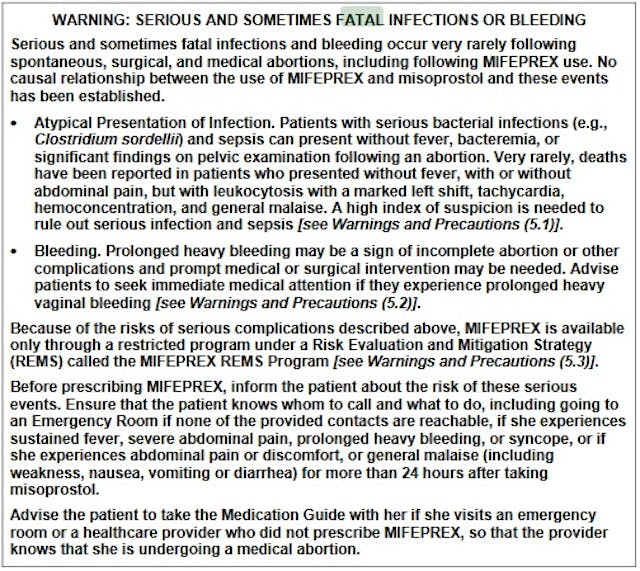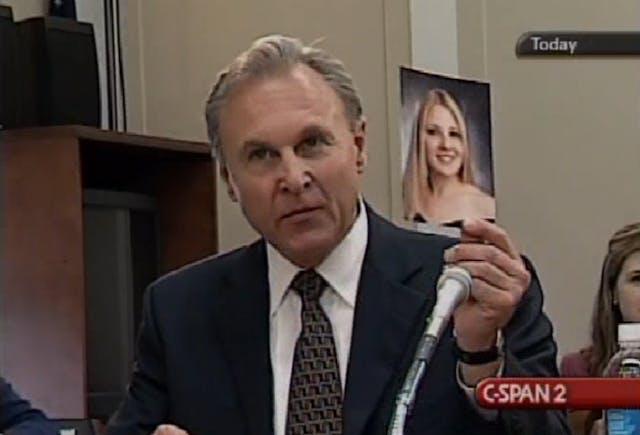
Korean scholars caution that assisted suicide, abortion laws risk undermining ethical foundations
Angeline Tan
·
Abortion Pill·By Carole Novielli
This abortionist claims the abortion pill doesn’t need regulations. He’s wrong.
A recent editorial by Dr. Daniel Grossman published by US News and World Report attempts once again to make the case for unregulated abortion. The abortion industry used the FDA to manipulate the speedy approval of the medication abortion regime known as RU-486 — and now they are decrying the FDA’s safety regulations as “unscientific.” But it is more regulation by the Food and Drug Administration (FDA), not less, that is needed with regard to medication abortion.
US News describes author Grossman as a “professor in the department of obstetrics, gynecology and reproductive sciences at the University of California, San Francisco, where he is the director of Advancing New Standards in Reproductive Health [ANSIRH].” What isn’t mentioned is that Grossman is an abortionist and has a previous association with the manufacturer of the abortion pill. According to IBIS Reproductive Health where Grossman is a senior advisor, prior to joining IBIS in 2005, Grossman was a health specialist at the Population Council in Mexico City. In 1994, with the encouragement of President Bill Clinton’s administration, Roussel-Uclaf (RU-486’s original manufacturer) turned over U.S. rights of the drug to the Population Council of New York, which began the clinical trials needed for FDA approval. The council then created Danco Laboratories to market RU-486. In 2000, the FDA approved the abortion pill regimen consisting of the drug Mifeprex (mifepristone) along with Misoprostol.

Grossman’s associations include more than just the Population Council. According to Grossman’s own testimony before a United States District Court in 2014, he also provides clinical services, including abortion, as a consultant to Planned Parenthood Shasta Pacific, and serves as a liaison member of the Planned Parenthood Federation of America National Medical Committee. And, in 2010, at a National Abortion Federation Annual Meeting, Grossman received an award for IBIS’s research evaluating the use of telemedicine to “improve access to abortion in rural settings.” Grossman begins his misleading editorial this way:
Sixteen years ago this week, the U.S. Food and Drug Administration approved mifepristone, sometimes referred to as RU-486, for early medication abortion. Hopes were high back then that the drug would revolutionize abortion access, taking the procedure out of clinics and moving it into the privacy of women’s homes. If every doctor in America – or at least every OB-GYN – could offer this option, women’s access to abortion would improve dramatically. Women might also avoid protesters at abortion clinics if they could just go to their regular doctor. Of course, things did not turn out this way. Few physicians who do not offer suction abortion provide mifepristone, so most women who want this method still have to go to an abortion clinic.
Come again? According to a 2009 study which collected information regarding medical abortion practices of National Abortion Federation (NAF) members for the year 2001, over 75% began offering mifepristone/misoprostol abortions within 5 months of the start of mifepristone distribution. As for Grossman’s assertion that few physicians who do not offer suction abortion provide mifepristone, this is misleading because it is a requirement of the FDA (for safety reasons) that this deadly abortion concoction be provided at a hospital, doctor’s office or clinic. The most recent changes to the regimen state:
Healthcare providers who would like to become certified to prescribe Mifeprex must have the ability to date pregnancies accurately and to diagnose ectopic pregnancies. Healthcare providers must also be able to provide any necessary surgical intervention, or have made arrangements for others to provide for such care. Healthcare providers must be able to ensure that women have access to medical facilities for emergency care, and must agree to other responsibilities, including reviewing and signing the Patient Agreement Form with the patient and providing each patient with a copy of the signed Patient Agreement Form and the Medication Guide.
Grossman continues:
States limit access to medication abortion in a number of ways. In most states, only a physician can provide medication abortion, despite the evidence that this option can be safely provided by nurse practitioners, nurse midwives and physician assistants… Further, some states require physicians to follow the protocol described in the FDA-approved labeling of mifepristone that was, up until recently, out of date and not consistent with published evidence. For every other drug, doctors are allowed to use medications according to published evidence, even if this differs from protocols described in a drug’s label. This so-called off-label use of medications is quite common, especially in obstetrics and pediatrics… It is time for these dispensing restrictions on mifepristone to be removed. After 16 years of experience with medication abortion, it is clear that this option is very safe.
I always find the idea of “safe” abortion a misnomer of sorts. First, abortion is never “safe” for the preborn child. In addition, there have never been national requirements that abortion complications be reported. And, while it is true that adverse effects of the abortion pill regimen were supposed to be reported to drug marketer Danco, a letter from the Department of Health and Human Services written to Rep. Mark Souder clearly suggests that the reports are “voluntary.”
That letter also reported that of the adverse effects cases of medication abortion received by the agency at that time, 116 patients needed a blood transfusion after serious heavy bleeding from the abortion drug, one quarter were hospitalized and less than one percent died. Although the age of the majority of patients experiencing these complications was over 18, there were cases reported in girls as young as 13 and as old as 46 years of age, yet Grossman now wants the FDA to remove the restrictions on how mifepristone is dispensed to teens. Grossman’s argument that the abortion pill is “safe” is completely contradictory to statements from the FDA which warn women in the 2016 label that…
Article continues below
Dear Reader,
In 2026, Live Action is heading straight where the battle is fiercest: college campuses.
We have a bold initiative to establish 100 Live Action campus chapters within the next year, and your partnership will make it a success!
Your support today will help train and equip young leaders, bring Live Action’s educational content into academic environments, host on-campus events and debates, and empower students to challenge the pro-abortion status quo with truth and compassion.
Invest in pro-life grassroots outreach and cultural formation with your TRIPLED year-end gift!
… [I]nformation on serious adverse reactions was reported in six U.S. and four non-U.S. clinical studies, totaling 30,966 women through 70 days gestation… Serious adverse reaction rates were similar between U.S. and non-U.S. studies, so rates from both U.S. and non-U.S. studies are presented.
Serious adverse reactions included the need for a blood transfusion, sepsis, ER visits, hospitalization related to medical abortion, infection without sepsis, hemorrhage, and deaths, which they claim are “rare.” In addition, voluntary reports to the FDA (not included in any of the clinical studies) paint a picture that is far from “safe” as Grossman suggests. The (post marketing) complications include:
Infections and infestations
Blood and the lymphatic system disorders
Anemia
Immune system disorders
Psychiatric disorders
Cardiac disorders
Vascular disorders
Respiratory, thoracic and mediastinal disorders
Gastrointestinal disorders
Connective tissue and bone disorders
Reproductive system and breast disorders
General disorders and administration site conditions

The FDA has received recent reports of serious adverse events in women who took Mifeprex. The reports include one case of ectopic pregnancy resulting in death; several cases of severe systemic infection (sepsis), including some that were fatal; and a single case of non-fatal heart attack. In fact, the FDA label warns just how serious the use of Mifeprex can be, describing it as possibly “fatal.” The FDA adds that the risk of “serious complications” are exactly why they have specific requirements in place, stating, “Because of the risks of serious complications described above, MIFEPREX is available only through a restricted program under a Risk Evaluation and Mitigation Strategy (REMS) called the MIFEPREX REMS Program.” And they warn doctors, “Before prescribing MIFEPREX, inform the patient about the risk of these serious events.” In addition, the FDA calls their requirements “necessary,” and explains why:
After reviewing the data and information submitted by the drug company that markets Mifeprex, and after taking into consideration the safety data that have become available since the initial approval of Mifeprex in 2000, the FDA concluded that certain restrictions continue to be necessary to ensure the safe use of the drug.
Grossman, with his deep ties to the abortion industry, belittles the risks and minimizes even death from the abortion pill regimen. While Grossman admits that women have died from medication abortion, he dismisses their deaths as a small percentage — mere statistics.
One such “statistic” was named Holly Patterson, and her death from an off-label abortion regimen at Planned Parenthood devastated her family. In an affidavit submitted by Monty Patterson, Holly’s grief-stricken father, he claims that Planned Parenthood, “made it seem that Mifeprex was a ‘miracle drug’ and that medical abortion would be like a ‘walk in the park.'”

His testimony was emotional, reading in part:
My daughter Holly was a beautiful 18-year young woman. Unbeknownst to me until that fateful day, Planned Parenthood prescribed my daughter an unapproved/off-label mifepristone (commonly known as RU-486, U.S. trade name Mifeprex, The Abortion Pill) and misoprostol medical abortion drug regimen. I first learned of it when I received a call from the hospital stating that she was there and in serious condition. Later that day, while at her bedside, my daughter tragically died from an infection known as Clostridium sordellii toxic shock syndrome that was associated with a medically induced abortion…. At the clinic, Holly was administered an un-approved (off-label/modified/alternative/evidence-based) regimen of 200-mg mifepristone orally which blocks the hormone progesterone that is required to maintain a pregnancy. At home, 24 hours later, on September 11, she followed the clinic’s off-label instructions to vaginally insert 800-mcg of misoprostol to induce labor contractions and expel the fetus. On September 13, Holly repeatedly called the Planned Parenthood clinic hotline to complain of severe cramping. She was told her symptoms were normal and to take the clinic prescribed Tylenol-Codeine painkiller. Later, Holly called the clinic’s hotline again and was told to go to a local hospital’s emergency room if the pain continued. By September 14, Holly was still experiencing extreme cramping and bleeding, and visited the emergency room of Valley Care Medical Center in Pleasanton on the fourth day after her initial visit to Planned Parenthood. The doctor there, whom she told about her abortion, sent her home after an injection of narcotics and yet more painkillers. The severity of the pain continued. Holly was weak, vomiting, and unable to walk. In the early morning hours of September 17, 2003, she was re-admitted to Valley Care Medical Center. Holly died on the seventh day after starting the mifepristone/misoprostol medical abortion regimen. This was the same day she was scheduled to return to Planned Parenthood for a follow up visit to make sure her abortion had been completed.
In their effort to legalize abortion, the abortion industry once pushed the idea that abortion outside the doctor’s office or clinic was “unsafe.” Now that they have accomplished their goal of legalization, the need for abortions to be performed in a so-called “safe” clinic by a licensed physician is suddenly unnecessary. The fact is that abortion will never truly be safe, and women who make the decision to have them could face complications and serious risks while at the same time ending the lives of their babies. Additionally, abortion is the only medical procedure that can be accessed by teen girls without their parent’s knowledge or permission in many states. For this reason, along with those the FDA has already outlined in their studies, the problem isn’t too much regulation by the FDA — the problem is that there isn’t enough of it.
Live Action News is pro-life news and commentary from a pro-life perspective.
Contact editor@liveaction.org for questions, corrections, or if you are seeking permission to reprint any Live Action News content.
Guest Articles: To submit a guest article to Live Action News, email editor@liveaction.org with an attached Word document of 800-1000 words. Please also attach any photos relevant to your submission if applicable. If your submission is accepted for publication, you will be notified within three weeks. Guest articles are not compensated (see our Open License Agreement). Thank you for your interest in Live Action News!

Angeline Tan
·
Analysis
Cassy Cooke
·
Politics
Bridget Sielicki
·
Human Interest
Andrea Trudden
·
Abortion Pill
Carole Novielli
·
Abortion Pill
Carole Novielli
·
Abortion Pill
Carole Novielli
·
Abortion Pill
Carole Novielli
·
Investigative
Carole Novielli
·
Abortion Pill
Carole Novielli
·
Investigative
Carole Novielli
·